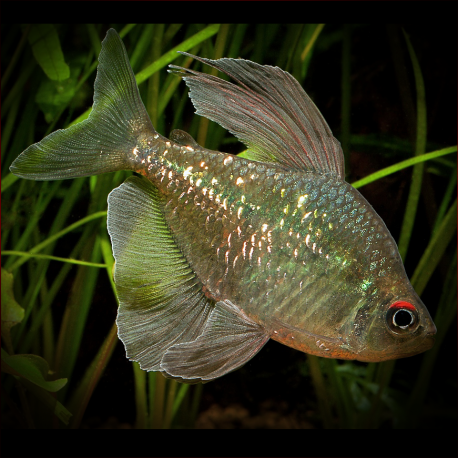More info
Datasheet
| Minimum Tank Size | 70 litres / 18.49 US gallons |
| Maximum Size | 6.0cm / 2.36inches |
| Temperature | 24°C / 75.20°F - 28°C / 82.40°F |
| Hardness | 5-12ºdH |
| pH | 5.5-7.0 |
General Description
The Diamond Tetra (Moenkhausia Pittieri) is a species that undergoes a remarkable transformation from a silvery, unassuming juvenile to a dazzling, diamond-like adult. With taxonomic uncertainties surrounding its genus, this tetra develops into a vibrant and colorful fish, making it a visually striking addition to any aquarium.
Aquarium Setup
The Diamond Tetra thrives best in well-maintained tanks with a preference for slightly acidic to neutral water conditions. Being adaptable, it can reside in alkaline environments but showcases its most vivid colors in acidic waters. This species flourishes in densely planted tanks or Amazonian biotope setups with dim lighting, suitable substrates, driftwood branches, and dried leaves for a natural feel.
Behaviour
Known for its peaceful nature and vibrant coloration, the Diamond Tetra is an excellent choice for community setups. It can coexist harmoniously with various fish species, including livebearers, danionins, rasboras, other tetras, gouramis, and dwarf cichlids. While it may exhibit fin-nipping behavior when kept in smaller numbers, maintaining a shoal of 6-8 specimens usually mitigates any aggression. Intriguing displays often occur between rival males when housed together.
Feeding and Diet
Easy to feed, the Diamond Tetra accepts a diverse diet of small live and frozen foods such as bloodworms, Daphnia, and brine shrimp, along with dried flakes and granules. Regular feeding of these nutritious foods ensures optimal health and vibrant coloration in this species.
Reproduction & Dimorphism
To breed Diamond Tetras, a separate tank with dim lighting, fine-leaved plants, or mesh for egg deposition is necessary. Water conditions should be soft, acidic, and well-maintained for successful spawning. Males display extended fins with a violet sheen, while females have clear fins. Successful breeding involves conditioning males and females with live foods, spawning either in groups or pairs, and removing adults after spawning to prevent egg consumption.
Habitat and Distribution
Endemic to Lake Valencia and its surrounding waters in Venezuela, the Diamond Tetra inhabits shallow, vegetated areas of the lake and slow-moving tributaries. Due to its native habitat's pollution levels and eutrophication events, commercial breeding farms in Eastern Europe or the Far East predominantly supply these fish for the aquarium trade.

